B2.1 Use the properties and order of operations, and the relationships between operations, to solve problems involving rational numbers, ratios, rates, and percents, including those requiring multiple steps or multiple operations.
Skill: Using the Properties of Operations
Most of the mathematics content related to the Number strand in Grades 7 to 10 can be addressed with the goal of developing algebraic thinking. Instead of asking students to memorize rules for performing operations on different numbers, it is more effective to "[…] move them beyond these particular cases and come to think about the underlying mathematical generalization (Beatty & Bruce, 2012; Ontario Ministry of Education, 2013). The goal is to have students observe and analyze a situation, as well as make various connections in order to formulate a generalization. Understanding number properties such as commutativity, associativity and distributivity is a prerequisite for simplifying algebraic expressions and solving equations. Simplifying and solving equations also requires an understanding of the meaning of an equality situation and the meaning of the equal symbol.
Exploring the various properties of operations requires examining the relationships between numbers and analyzing situations in which the change of one quantity has an effect on another quantity.
Commutative Property of Addition and Multiplication
When two numbers are added or multiplied, the equality remains true even if the order of the numbers is changed.
The student who makes this generalization understands the commutative property. This understanding helps them simplify algebraic expressions and solve equations. The student who does not understand the commutative property will perform addition or multiplication instead of comparing the terms on either side of the equal sign.
| ADDITION | MULTIPLICATION |
|---|---|
|
|
QUESTIONING
What do you notice about the order of the terms?
Do you think that changing the order of the terms changes the solution? How can you justify this?
Are the equalities in examples a) true? How do you know?
How did you determine the value of y in examples b)?
Have you thought of a strategy to verify your answer?
In both examples c), how did you use the commutative property to simplify the expressions?
Associative Property
When numbers are added or multiplied, they can be combined in various ways without changing the result of the operation; the equality remains true. The student who makes this generalization understands that when using the associative property, the order of the numbers is maintained, but the brackets are moved. Understanding this property allows students to simplify algebraic expressions and solve equations.
| ADDITION | MULTIPLICATION |
|---|---|
|
\((40\; +\; - 5)\; +\; - 30\; = \;40\; + \; (- 5 \;+\; - 30)\) \((2x \;+ \;- 3)\; + \;- 4 = 2x + \;( - 3 \;+\; - 4)\) |
\((10 \;\times\;- 2)\; \times \;5 = 10 \; ( - 2\; \times \;5\)) \((3x \;\times\;- 2)\; \times \;4 = 3x\; (- 2\; \times \;4)\) |
QUESTIONING
What are you comparing when you observe equality?
How can you explain the combinations?
What do you notice about the order of the terms?
Do you think the combinations changes modify the solution? Justify your thinking.
Distributive Property
The distributivity property allows a number in a multiplication expression to be composed into two or more numbers and get the same result.
The problem below is a typical example of what can be presented to the student to help them to understand the distributive property of multiplication.
Example
An auditorium contains 16 rows of 34 seats. How many seats are there in the auditorium?
The use of the context of an auditorium is no accident. It is a context conducive to the exploration of the area model.
A well-orchestrated instructional sequence supports the student to use an area model:
- using concrete materials (for example, base ten blocks, algebraic tiles);
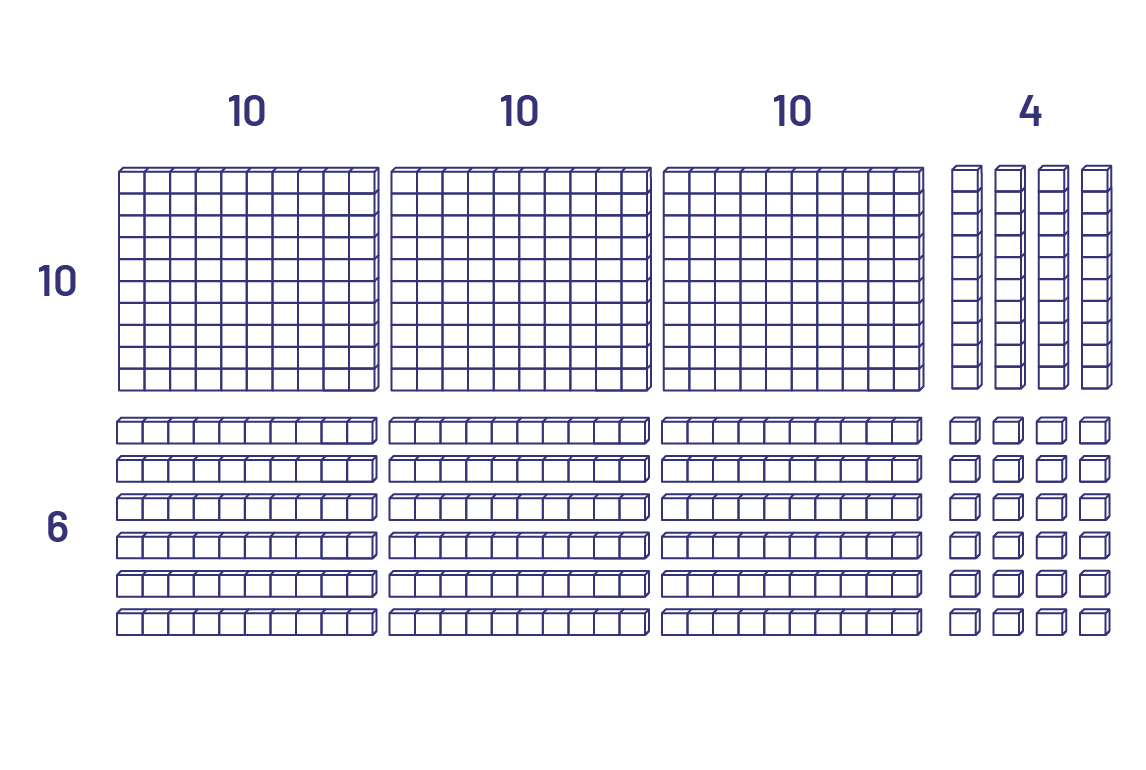
- using visual (semi-concrete materials) (for example, graph paper)
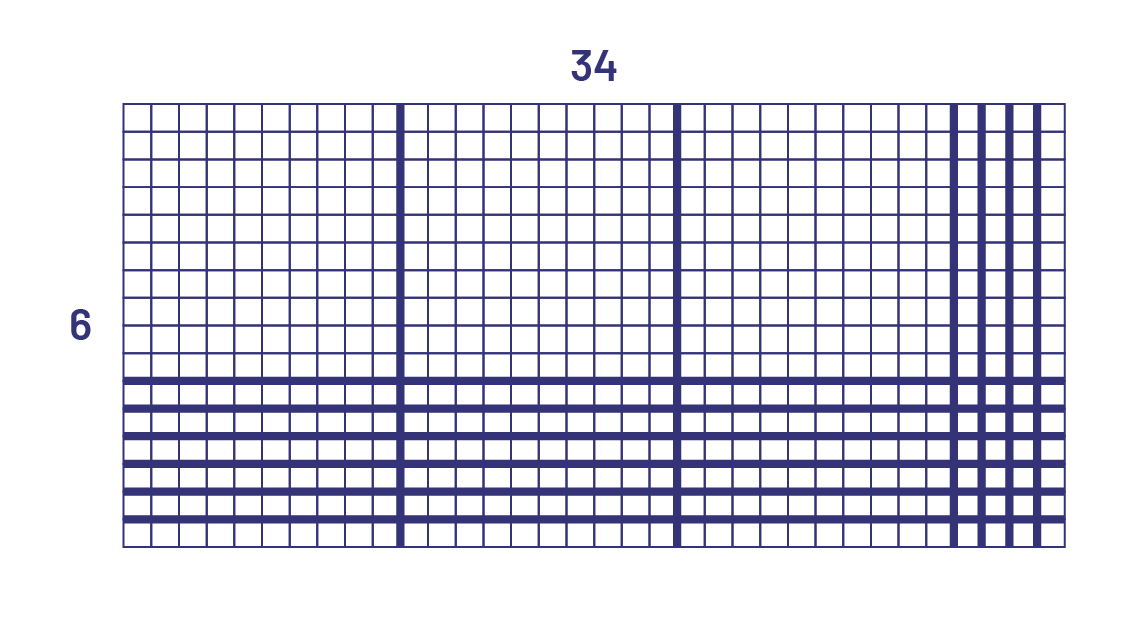
- using a more abstract representation (for example, open array).
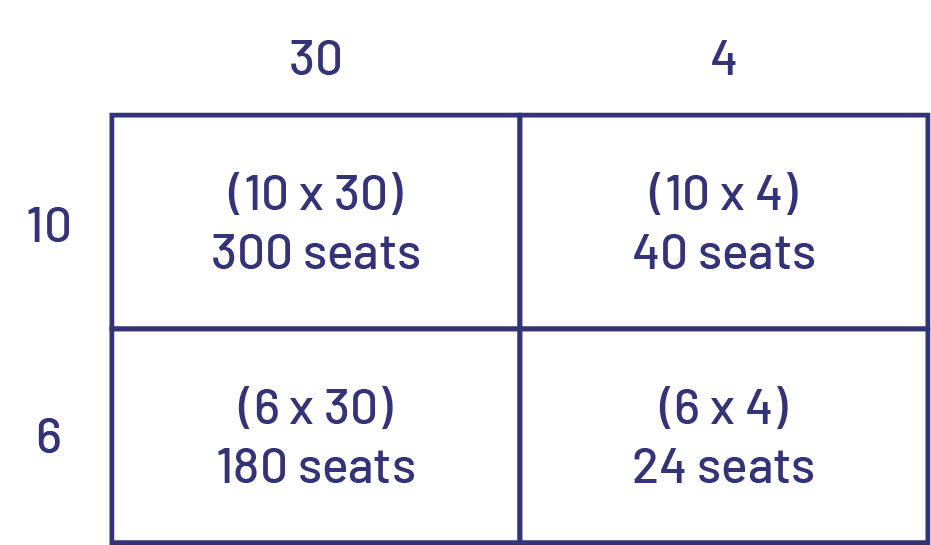
The strategy related to the concept of area that involves making sums of partial products helps the student generalize and understand the distributive property of multiplication over addition and how it connects to the standard multiplication algorithm.
The area model can be applied to multiplication with fractions and decimal numbers, as well as to algebraic situations.
| MULTIPLICATION OF FRACTIONS | MULTIPLICATION OF ALGEBRAIC EXPRESSIONS |
|---|---|
| Calculate \(4\frac{1}{2}\; \times \;8\frac{1}{4}\). | Simplify \((x\; + \;3)(x\; + \;2)\). |
  |
  |
|
\(\begin{array}{l}\quad 4\frac{1}{2}\; \times \;8\frac{1}{4}\\ = \;(4\; \times \;8 )\; + \;(4\; \times \;\frac{1}{4})\; + \;(\frac{1}{2}\; \times \;8)\; + \; (\frac{1}{2}\; \times \;\frac{1}{4})\\ = \;32 + 1 + 4 + \frac{1}{8}\\ = \;37 \frac{1}{8}\end{array}\) |
\(\begin{array}{l}\quad (x\; + \;3)\; \times \;(x\; + \;2)\\ = {x^2}\; + \;3x \; + \;2x\; + \;6\\ = {x^2}\; + \;5x\; + \;6\end{array}\) |
It is important students explore in parallel whether the commutative, the associative and the distributive properties apply to subtraction and division. The associative and the commutative properties do not apply to subtraction or division. The distributive property does not apply to division.
| SUBTRACTION | DIVISION | |
|---|---|---|
| ASSOCIATIVE PROPERTY |
\(\begin{array}{l}(a\; - \;b)\; - \;c\; \ne \;a\; - \;(b\; - \;c)\\(10 \; - \;2)\; - \;3\; \ne \;10\; - \;(2\; - \;3)\\5\; \ne \;11\end{array}\) |
\(\begin{array}{l}(a\; \div \;b)\; \div \;c\; \ne \;a\; \div \;(b\; \div \;c) \\(48\; \div \;4)\; \div \;2\; \ne \;48\; \div \;(4\; \div \;2)\\6\; \ne \;24\end{array}\) |
| COMMUTATIVE PROPERTY |
\(\begin{array}{l}a\; - \;b\; \ne \;b\; - \;a\\36\; - \;27\; \ne \;27\; - \;36\end{array}\) |
\(\begin{array}{l}a\; \div \;b\; \ne \;b\; \div \;a\\120\; \div \;5\; \ne \;5\; \div \;120\end{array}\) |
| DISTRIBUTIVE PROPERTY |
\(\begin{array}{l}a\; \div \;(b\; + \;c)\; \ne \;(a\; \div \;b)\; + \;(a\ ; \div \;c)\\24\; \div \;(4\; + \;8)\; \ne \;(24\; \div \;4)\; + \;(24\; \div \;8)\\24\; \div \;12\; \ne \;6\; + \;3\\2\; \ne \;9\end{array}\) |
Source: translated from Guide d'enseignement efficace des mathématiques de la 7e à la 10e année, Fascicule 2, Algèbre, p. 18-22.
Algebraic Generalizations
Students should master the following algebraic generalizations related to the properties of real numbers.
Commutative Property:
For all a and b elements of ℝ (real numbers), \(a + b = b + a\).
For all a and b elements of ℝ (real numbers), \(a \times b = b \times a\).
Associative Property:
For all a, b and c elements of ℝ (real numbers), \((a + b\,) + c = a + (b+ c\,)\).
For all a, b , and c elements of ℝ (real numbers), \(\left( {a \times \;b\,} \right)\; \times \;c\; = \;a \times \;\left( {b \times \;c\,} \right)\).
Distributive Property:
For all a, b , and c elements of ℝ (real numbers), \(a\;\,\left( {b + \;c} \right)\; = \;ab\; + \;ac\).
Identity Rule:
For all a elements of ℝ (real numbers), \(a + \;0\; = \;0\; + \;a = \;a;\;a\;-\;0\;=\;a\).
For all a elements of ℝ (real numbers), \(a \times \;1 = \;1 \times \;a = \;a;\;a\;\div \;1\;=\;a \).
Zero Property of Multiplication:
For all a elements of ℝ (real numbers), \(a \times \;0\; = \;0\; \times \;a = \;0\).
Source: translated from Guide d'enseignement efficace des mathématiques de la 7e à la 10e année, Fascicule 2, Algèbre, p. 24-25.
Skill: Use the Order of Operations
The order of operations can occur in a problem-solving context or in operations presented as numerical expressions without context.
In the classroom, it is more important to focus on the meaning of expressions in a problem-solving context than on the ability to evaluate expressions with multiple operations.
Operations in a Problem-Solving Context
To solve a problem involving a series of operations, the order to be followed is dictated by the meaning of the problem.
Example 1
Simon has 3 envelopes containing 5 stamps each and his sister Annabelle has 7 envelopes containing 4 stamps each. They decide to put all their stamps together to form a larger collection. How many stamps are in their joint collection?
To solve this problem logically, students must first determine the number of stamps in Simon's collection (\(3\; \times \;5\; = \;15\)), then the number of stamps in Annabelle's collection (\(7\; \times \;4\; = \;28\)). Then they have to find the total number of stamps in the 2 collections (\(15\; + \;28\; = \;43\)). Here, multiplication takes precedence over addition.
To represent all these operations in a single numerical expression, we could write \(3 \times \;5 + \;7 \times \;4\). However, this expression can be confusing. That's why it's better to use brackets to specify the order in which the operations must be performed, that is, \((3\; \times \;5)\; + \;(7\; \times \;4)\). The solution can then be presented as follows:
\(\begin{align}(3\; \times \;5)\; + \;(7\; \times \;4)\; &= 15\; + \;28 \\ &= \;43 \end{align}\)
The joint collection therefore contains 43 stamps.
In the following example, it is possible to solve the problem by giving priority to addition over multiplication.
Example 2
Alphonse orders 12 comic books at a cost of $7 each. There is a $2 delivery charge per book. How much do the 12 books cost him?
Students can first determine the price of each book \(\left( {\$7\; \; + \;\$2\; \; = \;\$9\; } \right)\), then the total cost \(\left( {\$12\; \; \times \;\$9\; \; = \;\$108\; } \right)\). As in the previous example, it is possible to present both operations with brackets in the same numeric expression: \((7\; + \;2)\; \times \;12\) or \(12\; \times \;(7\; + \;2)\).
Thus, brackets can be used to combine certain elements of a numerical expression and to specify that these elements must be processed first.
Operations in the Form of Numerical Expressions
Ideally, numeric expressions should be presented in a context that helps establish the order of operations. Sometimes, however, a numeric expression must be evaluated out of context. As discussed earlier, brackets help prioritize the operations to be performed, as in the numeric expressions \((3\; \times \;5)\; + \;(7\; \times \;4)\) and \(12\; \times \;(7\; + \;2)\). However, a numerical expression presented without brackets and without context could generate a multitude of responses. For example, one could decide to process the operations in the order in which they appear:
\(\begin{align}3\; \times \;5\; + \;7\; \times \;4\; &= 15\; + \;7\; \times \;4\\ &= 22\; \times \;4\\ &= \;88\end{align}\)
We could also decide to give priority to addition over multiplication:
\(\begin{align}3\; \times \;5\; + \;7\; \times \;4\; &= 3\; \times \;12\; \times \;4\\ & = 36\; \times \;4\\&= \;144\end{align}\)
When faced with a numerical expression of this kind, certain rules have been established to remove any ambiguity and to standardize its treatment. One of these rules is that multiplication and division are performed before addition and subtraction. In this context, the agreed way to evaluate the previous expression is:
\(\begin{align}3\; \times \;5\; + \;7\; \times \;4\; &= 15\; + \;28\\&= \;43\end{align}\)
The acronym BEDMAS is often presented to students to help them remember the set of rules that define the priority of operations. The "B" stands for the brackets that should be processed first. The "E" stands for exponents that are evaluated next. The "D" and "M" represent division and multiplication, operations to be performed in the order in which they appear. Finally, addition and subtraction correspond to the letters "A" and "S". These last two operations are performed last in the order in which they appear. The order of operations is part of the Grade 6 curriculum, but students in other grades may approach these rules informally. It is only in the intermediate grades that exponents are introduced. In the classroom, it is more important to focus on the meaning of expressions in a problem-solving context than on the ability to evaluate expressions with multiple operations.
Source: translated from Guide d’enseignement efficace des mathématiques de la 4e à la 6e année, Numération et sens du nombre, Fascicule 1, Nombres naturels, p. 108-110.
Some calculators respect the order of operations, while others do not (for example, if the keys \(3\; + \;4\; \times \;5\; = \) are pressed, a calculator that respects the order of operations would display 23, while a calculator that does not respect it would display 35). Students must then know the characteristics of their calculator, as well as the order of operations, so as to change the order of operations if necessary (for example, the keys would have to be pressed \(3\;\;(4\; \times \;5)\; = \) or \(4\; \times \;5\; + \;3\; = \) to get the correct answer on a calculator that does not respect the order of operations).
Source: translated from Guide d’enseignement efficace des mathématiques de la 4e à la 6e année, Numération et sens du nombre, Fascicule 1, Nombres naturels, p. 120
Skill: Using Relationships Between Operations
Understanding the properties of operations and the relationships between them allows for more flexible use.
Beginning in Grade 1, students make connections between operations through various activities. For example, they know that addition and subtraction are inverse operations and that addition is commutative. Over time, they develop their number sense and operations sense and gradually use them before performing operations. This practice, while often informal and mental, is still essential to understanding the relationships between numbers and between operations. By Grade 8, students should understand:
- Addition and subtraction are inverse operations.
- Multiplication and division are inverse operations.
- Multiplication can be associated with repeated addition.
- Division can be associated with repeated subtraction.
- Square roots and squares are inverse operations.
The fundamental operations of addition, subtraction, multiplication and division are closely related despite their apparent differences. The more opportunities students have to work with the operations, the more they can notice and understand the relationships between them.
Addition and Subtraction
There are four types of problems in addition and subtraction: changing (joining and separating), combining (part-part-whole) and comparing. In order for students to understand the connections between quantities in each of these cases, it is important that they be presented with a variety of problem types. The following table presents a variety of addition and subtraction problems.
Addition and subtraction are operations that can be used to solve problems. It is important to avoid referring to problems as "subtraction problems" or "addition problems" because it is the understanding of the situation that leads to the choice of fusing addition or subtraction to solve it. Thus, students must analyze the problem, choose a strategy and apply it, just as adults do. In this context, the teacher's role is to assist students in their analysis and understanding of operations.
It is important to note that the problems presented below appear similar because of their context. However, for students, each situation represents a unique problem. It is through experience with these different types of problems that students will become proficient with addition and subtraction.
Types of Addition and Subtraction Problems

Change (joining and separating) problems are perceived by students as active situations, easier to model and "see" as the initial quantity increases or decreases. Combine (part-part-whole) problems, however, assume a static situation, as no action or change occurs, making them more abstract and difficult to understand.
Compare problems, on the other hand, deal with the relationship between two quantities by finding the difference between them: there is no action, but a comparison of one quantity to another.
Since students are regularly exposed to problems whose final quantity is sought, they solve these kind of problems more easily and have more difficulty solving problems in which the variable is the starting quantity, added quantity, or removed quantity. These variation of problems help develop a more solid understanding of addition and subtraction and the relationships between them. For example, in addition problems where the unknown value is the start quantity, students more easily see the advantages of addition (for example, \(?\; + \;12\; = \;37 \)) which makes it possible to respect the order in which the action takes place in the problem. Some students may use a counting on or counting down strategy to determine the start quantity. These students demonstrate their understanding of the problem and their ability to use a strategy to solve it. However, they do not demonstrate an understanding of the meaning of difference (and subtraction). If they had used the subtraction \(37\; - \;12\; = \;?\), they would have demonstrated a broader understanding of the links between the quantities. Having said that, a strategy should not be imposed on students while they are learning. The obligation to subtract will not help students who do not see the relevance of this strategy. However, if they are regularly in contact with a variety of problems and participate in the mathematical conversations that follow, they can see the links between various strategies and assimilate a variety of strategies.
Source: translated from Guide d’enseignement efficace des mathématiques de la 4e à la 6e année, Numération et sens du nombre, Fascicule 1, Nombres naturels, p. 81-84.
Multiplication and Division
To understand multiplication and division, one must recognize the three types of quantities involved: the total quantity (for example, 8 flowers), the number of equal groups (for example, 4 pots), and the size of each group (for example, 2 flowers per pot).

In the problems presented to students, division is too often associated with only one type, which is the partitive sense of sharing. The grouping type is usually neglected. Division has a partitive or sharing meaning when the total quantity and the number of groups are known (for example, 3 students want to share 15 apples equally and we look for the number of apples each will receive).

Division has a grouping meaning (quotative division or “measurement division”) when the total quantity and the number of items in each group (group size) are known (for example, we have 15 apples and we want to put them in bags, 3 apples per bag; we look for the number of bags we need).

It is essential that both types of situations be addressed, as they are the basis for the integration of other mathematical concepts. It is not necessary for students to know the names of the situation types, but it is essential that they have the opportunity to solve a variety of problem types, while using a variety of strategies.
Types of Problems Related to Multiplication and Division

Source: translated from Guide d’enseignement efficace des mathématiques de la 4e à la 6e année, Numération et sens du nombre, Fascicule 1, Nombres naturels, p. 84-86.
Effect of Operations
Each operation has an effect on the quantities involved. Depending on the operation, certain quantities increase or decrease. They may increase or decrease by a lot or a little. Tracking the effect of operations on numbers allows students to make connections between operations and to anticipate the result of an operation. For example, if we subtract 8 from 160, we will notice little effect because the difference between 160 and 152 is relatively small. However, if we divide 160 by 8, the effect is large, because the resulting quotient, 20, is much smaller than 160. We can also compare the effect produced by addition to that produced by multiplication. Compared to multiplication, addition increases a number by a small amount. For example, when 160 is multiplied by 8, you get 1280, whereas if you add 8, you get 168. People with good operations sense recognize the effect of operations on natural numbers, but students who are learning are often impressed by the effect of, for example, multiplication. One caveat is that care must be taken when generalizing, as operations on decimal numbers or fractions may have different effects than those on natural numbers. In some cases, the effect may even be the opposite. For example, if you multiply one whole number by another whole number, the product is larger than both factors (for example, if you multiply 3 by 6, the product 18 is larger than 6 and 3), whereas if you multiply a proper fraction by a whole number, the product is smaller than either factor (for example, if you multiply \(\frac{1}{2}\) by 6, the product 3 is smaller than 6).
Source: translated from Guide d’enseignement efficace des mathématiques de la 4e à la 6e année, Numération et sens du nombre, Fascicule 1, Nombres naturels, p. 90-91.
Skill: Solving Problems Requiring Multiple Operations
Whether it is a problem with one operation or multiple operations, students must make decisions and choices based on the context. A problem-solving approach will introduce them to this thinking. When faced with a problem, they must first analyze it to determine the data and understand that a calculation must be performed. Then, depending on the context, one must know whether one is looking for an approximate or an exact answer. In both cases, depending on the context and the numbers involved, it is then necessary to determine whether the calculation will be performed mentally, in writing or using a calculator. Finally, the desired calculation is performed.
Diagram of the Students' Thinking About a Problem
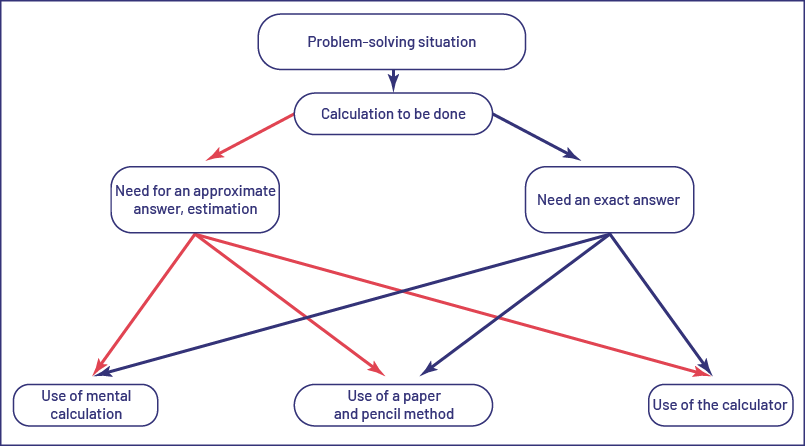
Knowledge: Set of Rational Numbers (ℚ)
A rational number is a number that can be written as a fraction. All decimal numbers except those with non-terminating decimals are rational numbers. Decimal numbers with non-terminating decimals are irrational numbers.
| Decimal part | Explanation | Example |
|---|---|---|
| Terminating decimal |
The decimal part contains a finite number of digits. Note: Numbers with a terminating decimal part can be represented by decimal fractions. |
\(0.5\;\left( {\frac{5}{{10}}} \right)\) \(1.458\;\left( {\frac{{1458}}{{1000}}} \right)\) |
| Non-terminating and repeating decimals | The decimal part contains an infinite number of digits, part of which (the period) repeats indefinitely. The period is placed above the repeated digit or group of digits.
Note: Numbers with non-terminating and repeating decimal parts can all be represented by fractions. |
\(0.353\;535 \ldots \;{\rm{ou}}\;{\;\rm{0.}}\dot{3}\dot{5} \;\left( {\frac{{35}}{{99}}} \right)\) \(0.666 \ldots \;{\rm{ou}}\;{\;\rm{0.}}\dot{6} \;\left( {\frac{2}{3}} \right)\) |
| Non-terminating and non-repeating decimal | The decimal part contains an infinite number of digits, without a repeating period.
Note: Non-terminating and non-repeating decimal numbers can not be represented by fractions. |
\(\sqrt 2 \; = \;1.414\;213\;56 \ldots \) \(\pi = \;3.141\;592\;6\;5 \ldots \) |
Knowledge: Properties of Operations
Properties of operations are characteristics that are specific to operations, regardless of the numbers involved.
The properties of the operations are:
- Commutative Property: \((3\; + \;5)\; = \;(5\; + \;3)\;\text{and}\;(3\; \times \;5)\; = \;(5\; \times \;3)\)
- Associative Property: \((2\; + \;9)\; + \;11\; = \;2\; + \;(9\; + \;11)\)
- Distributive Property: \(8\; \times \;7\; = \;8\; \times \;(5\; + \;2)\; = \;(8\; \times \;5)\; + \;(8\; \times \;2)\)
- Identity Principle: \(13\; + \;0\; = \;13\), \(0\; + \;13\; = \;13\); \(25\; \times \;1\; = \;25\), \(1\; \times \;25\; = \;25\); \(25\; \div \;1\; = \;25\);
- Zero Property of Multiplication: \(8\; \times \;0\; = \;0\), \(0\; \times \;8\; = \;8\).
Source: translated from Guide d’enseignement efficace des mathématiques de la 4e à la 6e année, Numération et sens du nombre, Fascicule 1, Nombre naturels, p. 102.
Knowledge: Commutative Property
A property of addition and multiplication that allows the numbers to be added or multiplied in any order, without affecting the sum or product of the operation. For example, \(27\; + \;63\; = \;63\; + \;27\) and \(8\; \times \;6\; = \;6\; \times \;8\).
Generalization: \(a\; + \;b\; = \;b\; + \;a\), \(a\; \times \;b\; = \;b\; \times \;a\)
Knowledge: Associative Property
The associative property is a property of addition and multiplication. It allows the terms of an expression to be combined in different ways without changing their value.
Generalization: \(\left( {a\; + \;b}\, \right)\; + \;c\; = \;a\; + \;\left( {b\; + \;c} \,\right) \), \((a\; \times \;b\,)\; \times \;c\; = \;a\; \times \;(b\; \times \;c\,)\)
Knowledge: Distributive Property
Multiplication is distributive over addition and subtraction.
The property that allows a number in a multiplication expression to be decomposed into two or more numbers. For example,
-
one can multiply \(3\; \times \;(5\; + \;6)\) and arrive at the same result as if one had performed \((3\; \times \;5)\; + \;(3\; \times \;6)\);
-
one can multiply \(3\; \times \;(20\; - \;2)\) as \((3\; \times \;20)\; - \;(3\; \times \;2)\).
Generalization: \(a\; \times \;(b\; + \;c\,)\; = \;(a\; \times \;b\,)\; + \;(a\; \times \;c\,)\)
Knowledge: Zero Property of Multiplication
When multiplying any number by 0, the result is always 0 (for example, \(684\; \times \;0\; = \;0;\;16.67\; \times \;0\; = \;0\)).
Generalization: \(a\; \times \;0\; = \;0\), \(0\; \times \;a\; = 0\)
Knowledge: Identity Property
The Identity Principle of Addition states that when adding 0 to any amount, the amount stays the same (for example, \(287\; + \;0\; = \;287\), \(4.5\; + \;0\; = \;4.5\; \). The Identity Property of Multiplication states that when multiplying an amount by 1, the amount stays the same (for example, \(133 \times \;1 = 133;\) \(432.1\; \times \;1\; = 432.1\). The Identity Property does not apply to subtraction. In a subtraction, the number 0 has no effect when it is the second term (for example, \(3\; - \;0\; = \;0\)), but it does not if it appears as first term (for example, \(0\; - \;3\; \ne \;3 \)). Similarly, in a division, the number 1 produces no effect when it is the divisor (for example, \(3\; \div \;1\; = \;3\)), but it is not the case if it appears as a dividend (for example, \(1\; \div \;3\; \ne \;3\)).
Generalization: \(a\; + \;0\; = \;a\), \(a\; - \;0\; = \;a\), \(a\; \times \;1\; = \;a\), \(a\; \div \;1\; = \;a\)
Source: translated from Guide d’enseignement efficace des mathématiques de la 4e à la 6e année, Numération et sens du nombre, Fascicule 1, Nombre naturels, p. 102-107.
Knowledge: Relationships Between Addition, Subtraction, Multiplication and Division
Operational sense involves the ability to represent situations with symbols and numbers. Understanding the meaning of the operations, and the relationships between them, allows one to choose the operation that best represents a situation and allows one to solve the problem most effectively, given the tools available.
- Addition and subtraction are inverse operations.
- Multiplication and division are inverse operations.
- Multiplication can be associated with repeated addition.
- Division can be associated with repeated subtraction.
Knowledge: Ratios
Relationship between two quantities expressed as the quotient of the numbers that characterize them.

For example, in the set of 5 marbles above,
- there is a ratio of 2 to 3 (\(\frac{2}{3}\) or 2:3) between the number of white marbles and the number of black marbles. (part: part ratio)
- there is a ratio of 2 to 5 (\(\frac{2}{5}\) or 2:5) between the number of white marbles and the total number of marbles. This can be interpreted as \(\frac{2}{5}\) marbles are white. (part: whole ratio)
Source: translated from Guide d’enseignement efficace des mathématiques de la 4e à la 6e année, Numération et sens du nombre, Fascicule 1, Nombre naturels, p. 55.
Knowledge: Rate
A rate describes the relationship between two quantities expressed in different units (for example, objects with dollars or kilometres with hours).
Source: translated from En avant, les maths! 4e, CM, Nombres, p. 2.
Knowledge: Percent
A percent is a kind of fraction. It is often used in everyday life. A numerical expression such as 30% (which reads "thirty percent") is actually another notation for the number thirty hundredths, or 0.30. To facilitate understanding of percents, students should first be introduced to the connection between the percent and the fraction with a denominator of 100 using concrete or visual (semi-concrete) materials.
Example
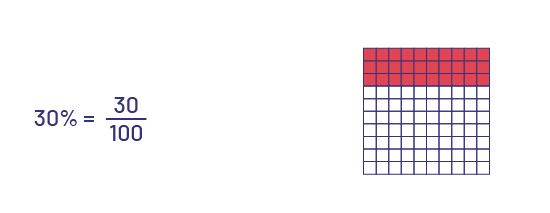
Students should also realize that a percent represents a ratio to 100 (for example, 30% represents the ratio 30:100). It is important to note that a result expressed as a percent does not mean that the quantity in question is necessarily composed of 100 parts, as explained in the following table.
Relationship Between Percent and the Quantity 100
| Representation | Percent | Instructional notes |
|---|---|---|
 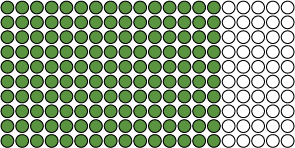 |
75% of the circles are green. | Even if 75% of the circles are green, it does not mean that there are 100 circles in the whole. However, if there were 100 circles, there would be 75 green circles. Also, the fraction of circles that are green is equivalent to \(\frac{75}{100}\) (for example, \(\frac{3}{4}\; = \;\frac{{75}}{{100}}\) and if the amount were doubled the corresponding fraction would be \(\frac{{150}}{{200}}\; = \;\frac{{75}}{{100}}\)). |
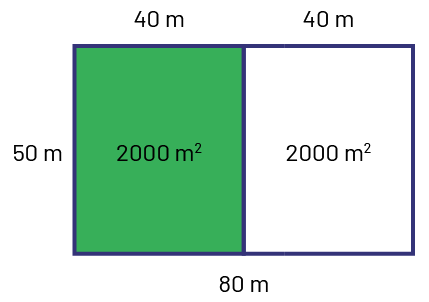 |
50% of the land is covered with grass. | Even if 50% of the field is covered with grass, it does not mean that the field has an area of 100 m2. The entire field is 4000 m2. If half of it is covered with grass, there would be 2000m2 of grass. Thus, \(\frac{2000}{4000} = \frac{1}{2} = \frac{50}{100} = 50\). |
Source: translated from Guide d’enseignement efficace des mathématiques de la 4e à la 6e année, Numération et sens du nombre, Fascicuel 3, Nombres décimaux et pourcentages, p. 34-35.
